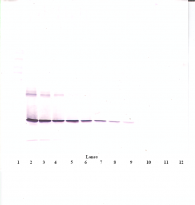ARG56713
anti-CNTF antibody
anti-CNTF antibody for ELISA,IHC-Formalin-fixed paraffin-embedded sections,Neutralizing,Western blot and Human
Overview
| Product Description | Rabbit Polyclonal antibody recognizes CNTF |
|---|---|
| Tested Reactivity | Hu |
| Tested Application | ELISA, IHC-P, Neut, WB |
| Host | Rabbit |
| Clonality | Polyclonal |
| Isotype | IgG |
| Target Name | CNTF |
| Antigen Species | Human |
| Immunogen | E.coli derived Recombinant Human CNTF. (AFTEHSPLTP HRRDLCSRSI WLARKIRSDL TALTQSYVKH QGLNKNINLD SADGMPVAST DQWSQLTQAQ RLQQNLQAYR TFHVLLARLL QDQQVHFTPT QGDFHQAIHT LLLQVAAFAY QIQQLMILLQ YKIPRNQADG MPINVGDGGL FQKKLWGLKV LQQLSQWTVR SIHDLRFISS HQTGIPARGS HYIANNKKM) |
| Conjugation | Un-conjugated |
| Alternate Names | HCNTF; CNTF; Ciliary neurotrophic factor |
Application Instructions
| Application Suggestion |
|
||||||||||
|---|---|---|---|---|---|---|---|---|---|---|---|
| Application Note | * The dilutions indicate recommended starting dilutions and the optimal dilutions or concentrations should be determined by the scientist. |
Properties
| Form | Liquid |
|---|---|
| Purification | Affinity purification with immunogen. |
| Buffer | PBS (pH 7.2) |
| Concentration | 1 mg/ml |
| Storage Instruction | For continuous use, store undiluted antibody at 2-8°C for up to a week. For long-term storage, aliquot and store at -20°C or below. Storage in frost free freezers is not recommended. Avoid repeated freeze/thaw cycles. Suggest spin the vial prior to opening. The antibody solution should be gently mixed before use. |
| Note | For laboratory research only, not for drug, diagnostic or other use. |
Bioinformation
| Database Links | |
|---|---|
| Gene Symbol | CNTF |
| Gene Full Name | ciliary neurotrophic factor |
| Background | The protein encoded by this gene is a polypeptide hormone whose actions appear to be restricted to the nervous system where it promotes neurotransmitter synthesis and neurite outgrowth in certain neuronal populations. The protein is a potent survival factor for neurons and oligodendrocytes and may be relevant in reducing tissue destruction during inflammatory attacks. A mutation in this gene, which results in aberrant splicing, leads to ciliary neurotrophic factor deficiency, but this phenotype is not causally related to neurologic disease. A read-through transcript variant composed of the upstream ZFP91 gene and CNTF sequence has been identified, but it is thought to be non-coding. Read-through transcription of ZFP91 and CNTF has also been observed in mouse. [provided by RefSeq, Oct 2010] |
| Function | CNTF is a survival factor for various neuronal cell types. Seems to prevent the degeneration of motor axons after axotomy. [UniProt] |
| Calculated MW | 23 kDa |
Images (5) Click the Picture to Zoom In
-
ARG56713 anti-CNTF antibody IHC-P image
Immunohistochemistry: Formalin-fixed and paraffin-embedded sections of Human breast invasive ductal carcinoma. The recommended ARG56713 anti-CNTF antibody concentration is 0.25 µg/ml with an overnight incubation at 4°C. An HRP-labeled polymer detection system was used with a DAB chromogen.
-
ARG56713 anti-CNTF antibody WB image
Western blot: 250 - 0.24 ng of Human CNTF stained with ARG56713 anti-CNTF antibody, under reducing conditions.
-
ARG56713 anti-CNTF antibody IHC-P image
Immunohistochemistry: Formalin-fixed and paraffin-embedded sections of Human breast invasive ductal carcinoma. The recommended ARG56713 anti-CNTF antibody concentration is 0.25 µg/ml with an overnight incubation at 4°C. An HRP-labeled polymer detection system was used with a DAB chromogen.
-
ARG56713 anti-CNTF antibody WB image
Western blot: 250 - 0.24 ng of Human CNTF stained with ARG56713 anti-CNTF antibody, under non-reducing conditions.
-
ARG56713 anti-CNTF antibody standard curve image
Sandwich ELISA: ARG56713 anti-CNTF antibody as a capture antibody at 0.5 - 2.0 µg/ml combined with ARG56822 anti-CNTF antibody (Biotin) as a detection antibody. Results of a typical standard run with optical density.










